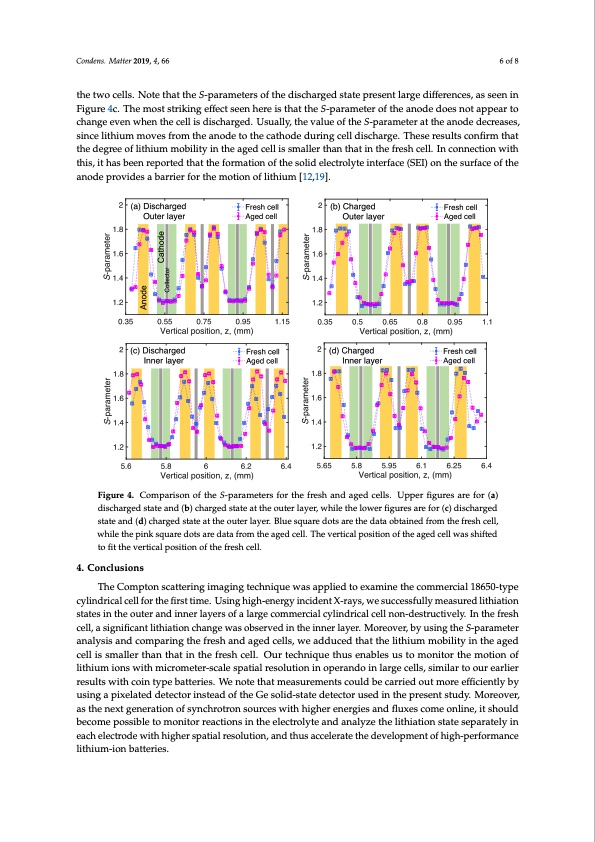
PDF Publication Title:
Text from PDF Page: 006
Condens. Matter 2019, 4, x FOR PEER REVIEW 6 of 8 to the discharged states whereas Figure 4b,d refers to the charged states. In the outer layer, the S- Condens. Matter 2019, 4, 66 6 of 8 parameter obtained from either cell is found to show reproducibility in the discharged and charged states (Figure 4a,b). However, the S-parameter at the inner layer displays significant differences the two cells. Note that the S-parameters of the discharged state present large differences, as seen in between the two cells. Note that the S-parameters of the discharged state present large differences, Figure 4c. The most striking effect seen here is that the S-parameter of the anode does not appear to as seen in Figure 4c. The most striking effect seen here is that the S-parameter of the anode does not change even when the cell is discharged. Usually, the value of the S-parameter at the anode decreases, appear to change even when the cell is discharged. Usually, the value of the S-parameter at the anode since lithium moves from the anode to the cathode during cell discharge. These results confirm that decreases, since lithium moves from the anode to the cathode during cell discharge. These results the degree of lithium mobility in the aged cell is smaller than that in the fresh cell. In connection with confirm that the degree of lithium mobility in the aged cell is smaller than that in the fresh cell. In this, it has been reported that the formation of the solid electrolyte interface (SEI) on the surface of the connection with this, it has been reported that the formation of the solid electrolyte interface (SEI) on anode provides a barrier for the motion of lithium [12,19]. the surface of the anode provides a barrier for the motion of lithium [12,19]. Figure 4.. Comparison of the S-parameters for the fresh and aged cells. Upperr ffiigures are for (a) discharged state and (b) charged state at the outer layer, while the lower fifigures are for (c) discharged state and((d))cchhaargrgeeddstsattaeteatathteheouotuetrelraylaeyr.erB.luBelusequsqaureardeotdsoatrseatrheetdhaetadaotbataoibnteadinferodmfrtohme ftrheeshfrceslhl, while the pink square dots are data from the aged cell. The vertical position of the aged cell was shifted cell, while the pink square dots are data from the aged cell. The vertical position of the aged cell was to fit the vertical position of the fresh cell. shifted to fit the vertical position of the fresh cell. 4. Conclusions 4. Conclusions The Compton scattering imaging technique was applied to examine the commercial 18650-type The Compton scattering imaging technique was applied to examine the commercial 18650-type cylindrical cell for the first time. Using high-energy incident X-rays, we successfully measured lithiation cylindrical cell for the first time. Using high-energy incident X-rays, we successfully measured states in the outer and inner layers of a large commercial cylindrical cell non-destructively. In the fresh lithiation states in the outer and inner layers of a large commercial cylindrical cell non-destructively. cell, a significant lithiation change was observed in the inner layer. Moreover, by using the S-parameter In the fresh cell, a significant lithiation change was observed in the inner layer. Moreover, by using analysis and comparing the fresh and aged cells, we adduced that the lithium mobility in the aged the S-parameter analysis and comparing the fresh and aged cells, we adduced that the lithium cell is smaller than that in the fresh cell. Our technique thus enables us to monitor the motion of mobility in the aged cell is smaller than that in the fresh cell. Our technique thus enables us to monitor lithium ions with micrometer-scale spatial resolution in operando in large cells, similar to our earlier the motion of lithium ions with micrometer-scale spatial resolution in operando in large cells, similar results with coin type batteries. We note that measurements could be carried out more efficiently by to our earlier results with coin type batteries. We note that measurements could be carried out more using a pixelated detector instead of the Ge solid-state detector used in the present study. Moreover, efficiently by using a pixelated detector instead of the Ge solid-state detector used in the present as the next generation of synchrotron sources with higher energies and fluxes come online, it should study. Moreover, as the next generation of synchrotron sources with higher energies and fluxes come become possible to monitor reactions in the electrolyte and analyze the lithiation state separately in online, it should become possible to monitor reactions in the electrolyte and analyze the lithiation each electrode with higher spatial resolution, and thus accelerate the development of high-performance state separately in each electrode with higher spatial resolution, and thus accelerate the development lithium-ion batteries. of high-performance lithium-ion batteries.PDF Image | High-Energy X-Ray Compton Scattering Imaging of 18650-Type Lithium-Ion Battery

PDF Search Title:
High-Energy X-Ray Compton Scattering Imaging of 18650-Type Lithium-Ion BatteryOriginal File Name Searched:
condensedmatter-04-00066-v2.pdfDIY PDF Search: Google It | Yahoo | Bing
Sulfur Deposition on Carbon Nanofibers using Supercritical CO2 Sulfur Deposition on Carbon Nanofibers using Supercritical CO2. Gamma sulfur also known as mother of pearl sulfur and nacreous sulfur... More Info
CO2 Organic Rankine Cycle Experimenter Platform The supercritical CO2 phase change system is both a heat pump and organic rankine cycle which can be used for those purposes and as a supercritical extractor for advanced subcritical and supercritical extraction technology. Uses include producing nanoparticles, precious metal CO2 extraction, lithium battery recycling, and other applications... More Info
| CONTACT TEL: 608-238-6001 Email: greg@infinityturbine.com | RSS | AMP |